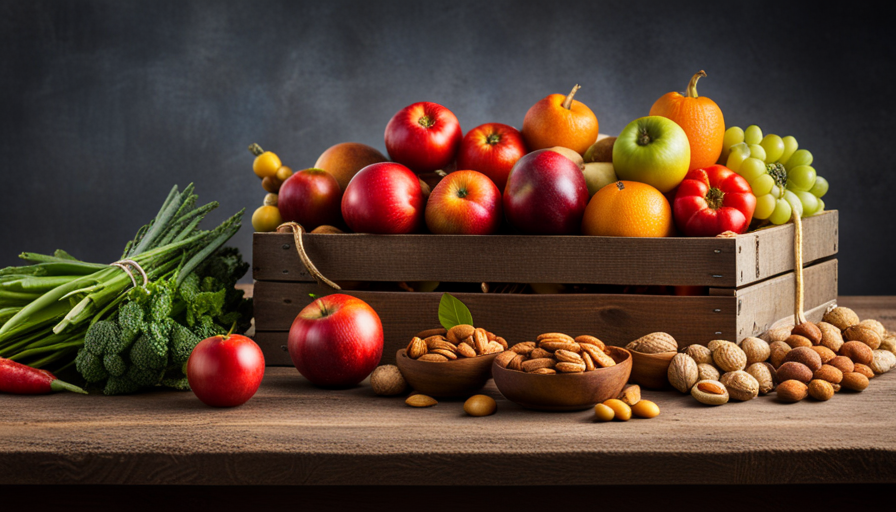What foods are consumed on a raw food diet?
It’s a question that has piqued my curiosity and led me down a path of exploration and discovery. Coincidentally, as I began exploring the world of raw food diets, I stumbled upon a fascinating truth – our ancestors thrived on raw, unprocessed foods for thousands of years.
This coincidence sparked my interest even further, prompting me to delve deeper into the topic. In this article, I will share with you the ins and outs of a raw food diet – what it entails, the benefits it offers, and the types of foods you can enjoy. I will also provide you with some meal ideas and recipes to help you get started.
But before we dive in, let’s address any potential challenges and precautions, as well as debunk some common myths and misconceptions surrounding this way of eating.
So, if you’re ready to embark on a journey of wellness and nourishment, let’s explore the world of raw food diets together.
Key Takeaways
- Raw food diet mainly consists of uncooked and unprocessed foods such as fruits, vegetables, nuts, seeds, and sprouted grains.
- Raw foods are nutrient-dense, high in antioxidants, and can help improve digestion, regulate blood sugar levels, and enhance energy levels.
- Transitioning to a raw food diet requires careful meal planning, experimenting with recipes, and slowly incorporating more raw foods into meals.
- Challenges of a raw food diet include meeting nutrient requirements, ensuring food safety, and addressing social isolation and meal planning difficulties.
Introduction to Raw Food Diet
If you’re looking to explore a new way of nourishing your body, a raw food diet might just be the answer you’ve been seeking. This alternative dietary approach involves consuming mainly uncooked and unprocessed foods.
The introduction of a raw food diet can bring about numerous benefits to your health. Firstly, raw foods are rich in essential nutrients such as vitamins, minerals, and enzymes that can support optimal bodily functions. Moreover, raw foods are known to be high in fiber, which can aid in digestion and promote a healthy gut. Additionally, by incorporating more raw foods into your diet, you may experience increased energy levels, improved skin health, and weight loss.
When it comes to meal ideas on a raw food diet, there are plenty of delicious options to choose from. You can start your day with a refreshing green smoothie made from leafy greens, fruits, and water. For lunch, a colorful salad with a variety of raw vegetables, nuts, and seeds can be both satisfying and nutritious. In the evening, you can enjoy zucchini noodles with a homemade raw sauce or a delicious raw veggie wrap filled with fresh produce.
Transitioning into the subsequent section about ‘what is a raw food diet?’ let’s explore the key principles and guidelines of this dietary approach.
What is a Raw Food Diet?
A raw food diet is a dietary approach that emphasizes the consumption of unprocessed and uncooked foods. This includes fruits, vegetables, nuts, seeds, and sprouted grains. The principles behind a raw food diet are based on the belief that cooking destroys essential nutrients and enzymes in food, and that consuming raw foods promotes better health and vitality.
While some proponents of the raw food diet argue that raw foods are more nutrient-dense and easier to digest, others argue that cooking food can enhance its nutritional value and make certain nutrients more bioavailable.
Definition and principles of a raw food diet
When you adopt a raw food diet, you’ll discover the powerful principles and transformative potential of consuming uncooked, unprocessed, and vibrant foods. This diet emphasizes the consumption of fruits, vegetables, nuts, seeds, and sprouted grains. The benefits of a raw food diet are numerous and include increased energy levels, improved digestion, weight loss, and reduced risk of chronic diseases. Additionally, raw food diet recipes are diverse and delicious, allowing for a wide variety of meals and snacks. To give you an idea, here is a sample of a day’s worth of meals on a raw food diet:
| Breakfast | Lunch | Dinner |
|---|---|---|
| Green smoothie | Raw veggie wrap with almond pate | Zucchini noodles with marinara sauce |
| Fresh fruit | Raw veggie salad with avocado dressing | Raw vegan sushi rolls |
| Raw nuts and seeds | Raw carrot cake bites | Large salad with mixed greens and sprouts |
Transitioning into the subsequent section about ‘raw vs. cooked food’, it’s important to understand the differences between these two approaches to nutrition.
Raw vs. cooked food
To make an informed decision about your nutritional choices, it’s essential to understand the differences between consuming raw and cooked foods. This includes the impact on nutrient availability and digestion.
For instance, imagine you’re recovering from a digestive disorder and advised to follow a raw food diet. Raw foods are rich in enzymes and nutrients that can support healing and provide optimal nourishment. Cooking, on the other hand, can lead to the loss of certain heat-sensitive vitamins and enzymes.
However, it’s important to note that cooking can also enhance the bioavailability of certain nutrients, such as lycopene in tomatoes. Additionally, some foods, like legumes, are more easily digested and their nutrients more readily absorbed when cooked.
Understanding the pros and cons of raw versus cooked foods can help you make informed choices about your diet.
Now let’s explore the benefits of a raw food diet.
Benefits of a Raw Food Diet
A raw food diet has several benefits that can greatly improve one’s overall health. Firstly, it allows for increased nutrient intake as raw foods are rich in vitamins, minerals, and enzymes that can be lost during cooking.
Secondly, this type of diet promotes improved digestion and weight management, as raw foods are easier to digest and can help regulate appetite.
Lastly, a raw food diet can enhance energy levels and boost overall health, as it is free from processed foods and additives that can cause fatigue and illness.
Increased nutrient intake
You’ll be amazed at the incredible boost in nutrient intake you experience on a raw food diet! Raw foods are packed with vitamins, minerals, and enzymes that are easily absorbed by the body. Cooking can diminish the nutrient content of foods, but by consuming them in their raw state, you maximize their nutritional value.
This increased nutrient absorption is one of the key benefits of a raw food diet. Raw fruits and vegetables are rich in antioxidants, which help protect the body against free radicals and reduce the risk of chronic diseases. Additionally, raw foods are high in fiber, which aids in digestion and promotes a healthy gut.
With this improved nutrient intake, your body will be better equipped to support overall health and wellness.
Transitioning to the next section, let’s explore how a raw food diet can enhance digestion and support weight management.
Improved digestion and weight management
Get ready to experience better digestion and effortlessly maintain a healthy weight with the incredible benefits of a raw food lifestyle.
When you switch to a raw food diet, you’ll notice a significant improvement in your digestion. Raw foods are rich in enzymes, which help break down food and make it easier for your body to absorb nutrients. This can alleviate common digestive issues like bloating, gas, and indigestion.
Additionally, a raw food diet can help with weight management. Raw foods are generally lower in calories and higher in fiber, which can help you feel fuller for longer and reduce cravings.
With improved digestion and weight management, you’ll be well on your way to achieving optimal health and vitality.
Transitioning into the next section, let’s explore how a raw food diet can enhance your energy levels and overall well-being.
Enhanced energy levels and overall health
Switching to a raw food lifestyle can lead to a surge in energy levels and a significant improvement in overall health. Many people who adopt a raw food diet report enhanced mental clarity and increased vitality throughout the day. This is because raw foods are rich in essential nutrients, enzymes, and antioxidants that promote optimal brain function and support a healthy immune system.
Additionally, the high fiber content in raw fruits and vegetables helps to regulate blood sugar levels, leading to sustained energy levels and improved mood. Moreover, the raw food diet is often associated with weight loss benefits due to its emphasis on whole, unprocessed foods that are naturally low in calories. By incorporating a variety of fruits, vegetables, nuts, and seeds into your diet, you can experience enhanced energy levels and overall health.
In the next section, we will explore the types of foods allowed on a raw food diet and how to incorporate them into your daily meals.
Types of Foods Allowed on a Raw Food Diet
When following a raw food diet, there are several types of foods that are allowed to be consumed. These include a variety of fruits and vegetables, which provide essential vitamins and minerals.
Additionally, nuts and seeds are a great source of healthy fats and protein, while sprouts and fermented foods offer probiotics and enzymes that can aid in digestion.
Overall, incorporating these types of foods into a raw food diet can provide a well-rounded and nutrient-rich eating plan.
Fruits and vegetables
Munching on a juicy, ripe watermelon slice is like having a burst of refreshing sweetness in every bite. Fruits and vegetables are a vital part of a raw food diet. They provide essential nutrients, fiber, and hydration.
Fruits like berries, oranges, and apples are packed with antioxidants, vitamins, and minerals. Leafy greens such as spinach, kale, and lettuce offer a wide range of nutrients, including iron and calcium. Incorporating a variety of fruits and vegetables into your raw food diet ensures a well-rounded nutritional intake.
However, it’s important to note that some fruits and vegetables are better suited for a raw food diet than others, as cooking can alter their nutritional value.
Transitioning to the next section, nuts and seeds are also key components of a raw food diet, providing healthy fats and protein.
Nuts and seeds
Nuts and seeds are like tiny powerhouses of nutrition, giving us a boost of healthy fats and protein. They are an essential part of a raw food diet, providing numerous health benefits.
Nuts, such as almonds, walnuts, and cashews, are rich in heart-healthy fats and are packed with vitamins, minerals, and antioxidants. Seeds, like chia seeds, flaxseeds, and hemp seeds, are excellent sources of omega-3 fatty acids, fiber, and plant-based protein.
Consuming nuts and seeds regularly can help lower the risk of heart disease, improve brain function, and promote healthy digestion. They also provide energy and help stabilize blood sugar levels.
Incorporating a variety of nuts and seeds into your raw food diet can provide a wide range of nutrients and flavors.
Now, let’s move on to the next section about sprouts and fermented foods.
Sprouts and fermented foods
Sprouts and fermented foods are like the colorful dancers at a food fiesta, adding a lively and vibrant touch to your plate. These nutrient-dense powerhouses not only enhance the flavor of your meals but also offer numerous health benefits.
Here are four reasons why incorporating sprouts and fermented foods into your raw food diet can be beneficial:
- Sprouts are packed with vitamins, minerals, and enzymes that promote digestion and boost your immune system.nn2. Fermented foods, such as sauerkraut and kimchi, are rich in probiotics that support gut health and improve digestion.nn3. Both sprouts and fermented foods are low in calories and high in fiber, making them ideal for weight management.nn4. They’re easy to grow at home and can add variety and texture to your dishes.
Now, let’s move on to exploring some exciting raw food meal ideas and recipes.
Raw Food Meal Ideas and Recipes
When it comes to meal ideas and recipes on a raw food diet, there are plenty of options to choose from.
Smoothies and juices are a great way to start the day and pack in nutrients from fruits and vegetables.
Raw salads and vegetable dishes offer a refreshing and crunchy option for lunch or dinner.
Raw desserts and snacks provide a guilt-free way to satisfy your sweet tooth.
With these choices, it’s easy to enjoy a variety of delicious and nutritious meals while following a raw food diet.
Smoothies and juices
Don’t miss out on the refreshing and vibrant smoothies and juices that’ll invigorate your taste buds on a raw food diet! Smoothies are a delicious way to incorporate a variety of fruits and vegetables into your diet.
There are countless smoothie recipes to choose from, allowing you to mix and match ingredients to suit your taste preferences. Whether you prefer a green smoothie packed with leafy greens or a tropical smoothie bursting with exotic fruits, the options are endless.
In addition to their delicious taste, smoothies and juices offer numerous health benefits. Juicing allows you to extract the nutrients from fruits and vegetables in a concentrated form, making it easier for your body to absorb and digest. This can provide a quick and convenient way to boost your intake of vitamins, minerals, and antioxidants.
As we move into the next section about raw salads and vegetable dishes, you’ll discover even more ways to enjoy the fresh and vibrant flavors of a raw food diet.
Raw salads and vegetable dishes
One great way to savor the vibrant flavors of a raw food lifestyle is by indulging in a variety of enticing raw salads and vegetable dishes. Raw food recipes offer a multitude of options when it comes to creating delicious and nutritious salads.
From refreshing cucumber and tomato salads to hearty kale and avocado salads, there is something for everyone. Raw vegetables are packed with essential nutrients and enzymes that are often lost during cooking. By consuming them in their raw form, we can maximize their health benefits.
Raw vegetables are rich in vitamins, minerals, and antioxidants, which can support a strong immune system, promote healthy digestion, and enhance overall well-being.
Transitioning into the subsequent section about ‘raw desserts and snacks,’ it’s important to find ways to satisfy our sweet tooth while maintaining a raw food diet.
Raw desserts and snacks
Indulge in delectable raw treats and snacks that’ll satisfy your sweet cravings and keep you nourished throughout the day.
Here are three raw dessert recipes and healthy snack options to try on a raw food diet:
-
Raw Chocolate Avocado Mousse: Blend ripe avocados, raw cacao powder, dates, and a touch of maple syrup for a creamy and decadent chocolate dessert.
-
Raw Energy Balls: Combine dates, nuts, and your choice of superfood add-ins like chia seeds or goji berries. Roll them into bite-sized balls for a quick and satisfying snack.
-
Raw Fruit Sorbet: Freeze ripe fruits like bananas or berries, then blend them until smooth. Enjoy this refreshing treat guilt-free.
These raw desserts and snacks aren’t just delicious but also packed with nutrients. They provide a healthy alternative to processed sweets.
Now, let’s dive into some tips for transitioning to a raw food diet.
Tips for Transitioning to a Raw Food Diet
When transitioning to a raw food diet, it’s important to slowly introduce more raw fruits and vegetables into your meals to allow your taste buds to adjust and truly appreciate the vibrant flavors and textures.
One of the key tips for transitioning is to focus on meal planning. Planning your meals in advance can help you ensure that you have a variety of raw foods on hand and make the transition easier. Start by incorporating more raw fruits and vegetables into your current meals, such as adding a side salad or a raw vegetable snack. Gradually increase the amount of raw foods in your meals until they become the main focus.
Another tip is to experiment with different recipes and techniques to keep your meals interesting and flavorful. Raw food diets can include a wide range of delicious options like raw soups, vegetable noodles, and raw desserts made from nuts and fruits.
Additionally, it’s important to stay hydrated and ensure you’re getting enough nutrients. Raw foods are generally high in water content and nutrients, but it’s still important to pay attention to your body’s needs and make sure you’re meeting them.
As you transition to a raw food diet, it’s important to be aware of potential challenges and precautions. These may include ensuring you’re getting enough protein, vitamins, and minerals, as well as considering any potential food allergies or sensitivities. It’s always a good idea to consult with a healthcare professional or registered dietitian before making any major dietary changes.
Potential Challenges and Precautions
Meeting nutrient requirements is a key consideration when transitioning to a raw food diet. It is important to ensure that you’re getting all the necessary vitamins, minerals, and macronutrients from your food sources.
Another important aspect to consider is food safety and hygiene, as consuming raw foods can increase the risk of foodborne illnesses.
Finally, potential social and practical challenges may arise when following a raw food diet. These challenges include finding suitable options when eating out and dealing with skeptical family and friends.
Meeting nutrient requirements
To ensure a balanced raw food diet, it’s essential to include a variety of nutrient-rich fruits, vegetables, nuts, and seeds. Meeting nutrient requirements on a raw food diet can be challenging, as some nutrients may be more difficult to obtain compared to a cooked food diet. However, with careful planning and consideration, it is possible to meet all your nutritional needs.
Balancing macronutrients is crucial to prevent deficiencies and maintain optimal health. Consuming a mix of fruits, vegetables, and leafy greens can provide carbohydrates, vitamins, and minerals. Nuts and seeds are excellent sources of healthy fats and protein. It’s important to pay attention to portion sizes and ensure you are getting enough calories to meet your energy needs.
By focusing on nutrient-dense foods and maintaining a well-rounded diet, you can thrive on a raw food diet.
Now, let’s move on to the next section about food safety and hygiene.
Food safety and hygiene
Ensure the safety and cleanliness of your food preparation area to protect yourself and your loved ones from potential health risks. Here are three important steps to follow when it comes to food storage and preparation on a raw food diet:
-
Properly store your raw food: Raw fruits, vegetables, and nuts should be stored in clean containers in the refrigerator to prevent spoilage and the growth of harmful bacteria.
-
Wash your produce thoroughly: Before consuming raw fruits and vegetables, it’s crucial to wash them under running water to remove any dirt, pesticides, or bacteria that may be present.
-
Separate raw and cooked foods: To avoid cross-contamination, keep raw and cooked foods separate. Use different cutting boards, utensils, and plates for raw and cooked foods to prevent the transfer of harmful bacteria.
By following these guidelines, you can ensure the safety and hygiene of your food preparation.
Moving on to potential social and practical challenges, it’s important to consider…
Potential social and practical challenges
Navigating the world of raw cuisine can be like embarking on a culinary adventure, as one encounters potential social and practical challenges along the way.
One of the challenges is social isolation, as the raw food diet isn’t widely understood or accepted by everyone. It can be difficult to find restaurants or social gatherings that cater to raw foodists, which may lead to feelings of exclusion or criticism from others.
Additionally, meal planning can be a practical challenge. Raw food diets require careful consideration of nutritional needs and variety, as well as proper food handling and preparation techniques. It may take time to learn new recipes and find suitable ingredients.
However, with dedication and creativity, these challenges can be overcome.
Transitioning to the next section, listening to your body on a raw food diet is essential for optimal health and well-being.
Listening to Your Body on a Raw Food Diet
Listen closely to your body’s needs and cravings while following a raw food diet, as it holds the key to unlocking a deeper understanding of your own health and well-being. When you listen to your body, you become more in tune with its intuitive eating signals.
Here are four important things to consider when listening to your body on a raw food diet:
-
Hunger and Fullness: Pay attention to your body’s hunger and fullness cues. Eat when you’re hungry and stop eating when you’re comfortably full. This can help you avoid overeating or undereating.
-
Cravings: Cravings can sometimes be a sign of nutrient deficiencies. If you’re craving a certain food, try to find a raw food alternative that provides similar nutrients. For example, if you’re craving something sweet, reach for a ripe piece of fruit.
-
Energy Levels: Notice how different foods make you feel. Some raw foods may give you an energy boost, while others may leave you feeling sluggish. Experiment with different foods to find what works best for your body.
-
Digestion: Pay attention to how your body digests different raw foods. Some foods may be easier to digest than others. If you notice any discomfort or digestive issues, adjust your raw food choices accordingly.
By listening to your body on a raw food diet, you can better understand its needs and make informed choices about the foods you consume.
Now, let’s explore some common myths and misconceptions about raw food diets.
Common Myths and Misconceptions about Raw Food Diets
When it comes to raw food diets, there are some common myths and misconceptions that need to be addressed.
One of the main concerns is protein and nutrient deficiencies. Contrary to popular belief, it’s possible to meet your protein and nutrient needs on a raw food diet by incorporating a variety of plant-based foods.
Additionally, digestive issues and food safety concerns can arise when consuming raw foods, but proper food preparation and hygiene can help mitigate these risks.
Lastly, the long-term sustainability of a raw food diet is often questioned. While some individuals may thrive on this lifestyle, it’s important to consider individual needs and potential challenges in maintaining a well-rounded and balanced diet over time.
Protein and nutrient deficiencies
Protein and nutrient deficiencies may arise when following a raw food diet. While raw foods can provide a variety of essential nutrients, it is important to ensure that you’re getting enough protein and other key nutrients.
Protein deficiencies can be a concern for those who rely heavily on raw fruits and vegetables, as they may not provide adequate amounts of this essential macronutrient. However, it’s important to note that there are plant-based sources of protein that can be included in a raw food diet, such as nuts, seeds, and sprouted grains.
Additionally, nutrient deficiencies can occur if the diet lacks variety and doesn’t include a wide range of fruits, vegetables, nuts, and seeds. To avoid these deficiencies, it’s important to carefully plan and diversify your meals.
Moving on to digestive issues and food safety concerns, it’s important to be aware of potential challenges that may arise.
Digestive issues and food safety concerns
I can’t emphasize enough the importance of ensuring proper digestion and food safety when following a raw food lifestyle – it’s like navigating through a culinary jungle, where one wrong step can lead to an upset stomach or worse. Digestive health is crucial for overall well-being, and it’s essential to take precautions to avoid foodborne illnesses. Raw foods can contain harmful bacteria and parasites, so it’s vital to wash produce thoroughly, handle it with clean hands, and store it properly. Additionally, some individuals may experience digestive issues when transitioning to a raw food diet, such as bloating or gas. It’s important to listen to your body and make adjustments as needed. Moving forward, let’s explore the long-term sustainability of a raw food diet and how it can be maintained for optimal health.
Long-term sustainability of a raw food diet
After discussing the digestive issues and food safety concerns associated with a raw food diet, it’s important to consider the long-term sustainability of this dietary approach.
While a raw food diet can provide numerous health benefits, there are also potential challenges that need to be addressed. One of the main concerns is the long-term health effects of following a raw food diet exclusively. Some studies suggest that certain nutrients, such as vitamin B12 and iron, may be lacking in a raw food diet, which could lead to deficiencies over time.
Additionally, maintaining a raw food diet can be challenging due to the limited variety of foods and the need for careful meal planning. It’s crucial to ensure that all nutritional needs are met in order to sustain long-term health.
Transitioning into the next section about ‘conclusion and personal reflections’, it’s important to reflect on the overall impact of a raw food diet.
Conclusion and Personal Reflections
Overall, you’ll find that embracing a raw food diet offers a refreshing and vibrant way of nourishing your body and mind. Personally, I have experienced significant personal growth and a heightened sense of well-being since adopting this lifestyle. However, it is important to maintain motivation and understand the challenges that may arise.
One of the key benefits of a raw food diet is the abundance of nutrients and enzymes present in uncooked fruits, vegetables, nuts, and seeds. These essential components are often lost through cooking and processing. By consuming raw foods, I have noticed increased energy levels, improved digestion, and enhanced mental clarity.
To help you visualize the benefits of a raw food diet, I have created a table showcasing the nutrient content found in common raw food ingredients compared to their cooked counterparts:
| Raw Food Ingredient | Cooked Food Ingredient |
|---|---|
| Spinach | Cooked Spinach |
| Almonds | Roasted Almonds |
| Tomatoes | Tomato Sauce |
| Carrots | Steamed Carrots |
| Broccoli | Steamed Broccoli |
By incorporating raw foods into your diet, you can maximize your nutrient intake and support your overall health. However, it is essential to listen to your body and make adjustments as needed. It may take time to adapt to this lifestyle, and maintaining motivation is crucial. Experiment with different recipes, join a supportive community, and educate yourself on the benefits of a raw food diet to stay inspired on your journey towards optimal health.
Frequently Asked Questions
Can I drink alcohol on a raw food diet?
Yes, it’s generally advised to avoid drinking alcohol on a raw food diet. Alcohol isn’t considered a natural or whole food and doesn’t align with the principles of a raw food diet. Additionally, alcohol can have negative effects on overall health and can interfere with the body’s natural detoxification process. It’s best to focus on consuming fresh fruits, vegetables, nuts, and seeds to optimize the benefits of a raw food diet.
Can I eat cooked food occasionally on a raw food diet?
Yes, you can eat cooked food occasionally on a raw food diet. While the main focus is on consuming raw, unprocessed plant-based foods, there are cooked food exceptions that can be incorporated. However, it’s important to choose healthier cooking methods such as steaming or baking instead of frying or grilling. Additionally, you can find raw food substitutes for cooked foods, like zucchini noodles instead of pasta or cauliflower rice instead of regular rice.
How does a raw food diet affect your energy levels?
A raw food diet can have a significant impact on energy levels. By consuming whole, unprocessed foods in their natural state, the body receives a rich supply of vitamins, minerals, and enzymes. These nutrients are easily absorbed and provide sustained energy throughout the day.
Compared to a cooked food diet, which can be high in processed carbohydrates and unhealthy fats, a raw food diet benefits overall health and vitality, leading to increased energy levels.
Can I still get enough protein on a raw food diet?
Yes, it’s possible to get enough protein on a raw food diet. While raw food diets mainly consist of uncooked fruits, vegetables, nuts, and seeds, there are still plenty of protein sources available. Foods like almonds, chia seeds, hemp seeds, and spirulina are all excellent sources of protein. It’s important to ensure that you include a variety of these protein-rich foods in your diet to meet your protein needs on a raw food diet.
Are there any specific vitamins or supplements I should take while on a raw food diet?
Supplement recommendations for a raw food diet are crucial in order to avoid nutrient deficiencies. While the raw food diet can provide many essential vitamins and minerals, it may lack certain nutrients like vitamin B12, iron, and omega-3 fatty acids.
To ensure adequate intake, I recommend considering supplements such as a B12 supplement, iron supplement, and a plant-based omega-3 supplement derived from algae. It’s important to consult with a healthcare professional to determine your specific needs.
How Does A Raw Food Diet Differ for Raw Food Vegans?
Raw vegan food options are a crucial part of a raw food diet for raw food vegans. Unlike other raw food diets, raw food vegans do not consume any animal products, focusing on fruits, vegetables, nuts, and seeds. This requires finding creative and diverse raw vegan food options to meet their nutritional needs.
Conclusion
As I reflect on my journey with the raw food diet, I can’t help but feel a sense of wonder and excitement. The benefits I’ve experienced, both physically and mentally, have far surpassed my expectations.
From increased energy levels to improved digestion, this lifestyle change has truly transformed my life. But what’s even more intriguing is the potential for continued growth and discovery.
As I delve deeper into this world of raw foods, I can’t help but feel a sense of anticipation. What other hidden treasures await? Only time will tell.
So, if you’re ready to embark on this adventure, I encourage you to take that first step. The raw food diet may just be the key to unlocking your true potential.










